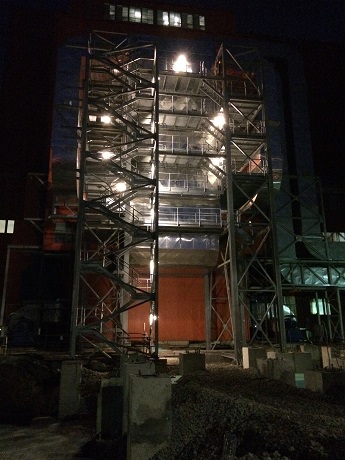Flue Gas Cleaning
DeNOx SCR Systems
Selective Catalytic ReductionThe DeNOx SCR unit is used for the reduction of $\ce{NOx}$ content in the flue gas out of the boiler. The process of DeNOx SCR reduces nitrogen oxides $\ce{NOx}$ of combustion flue gases into molecular nitrogen $\ce{N2}$ and water vapor $\ce{H2O}$.
$\ce{4NO + 4NH3 + O2 -> 4N2 + 6H2O}$
$\ce{2NO2 + 4NH3 + O2 -> 3N2 + 6H2O}$
$\ce{NO + NO2 + 2NH3 -> 2N2 + 3H2O}$
$\ce{2NO2 + 4NH3 + O2 -> 3N2 + 6H2O}$
$\ce{NO + NO2 + 2NH3 -> 2N2 + 3H2O}$
$\ce{NOx}$ breaks down when it reacts with the reducing agent $\ce{NH3}$, in the presence of the catalyst. The ammonia $\ce{NH3}$ is distributed into the flue gas prior to the catalyst The catalyst, by providing active reaction sites, allows the reaction to occur at lower temperatures than usually used for this kind of reaction. The $\ce{NH3}$ diffuses into the catalyst pore structure and is adsorbed onto an active catalyst site. The $\ce{NOx}$ then reacts with the adsorbed $\ce{NH3}$, completing the reaction. The reaction depends primarily on available active sites (a function of geometric surface area, pore volume, and concentration of active catalyst component), flue gas temperature and reagent concentration. A well-balanced process will maintain appropriate output levels of residual $\ce{NOx}$ and $\ce{NH3}$.
DeNOx Systems
Converting nitrogen oxides

For the $\ce{NH3}$ supply, aqueous ammonia $\ce{NH4OH}$ or urea is stored in tanks and evaporated by the vaporizer, mixed with hot dilution air and injected into the flue gas before the catalyst.
High-Dust
- Coal Fired Boiler
- Cement Rotary Kiln
- Biomass Fired Boiler
- Presence of different pollutants
- In between the existing heat recovery system
Low-Dust
- Gas Fired Boiler (HRSG)
- Oil Fired Boiler
- WtE (not recommended)
- Presence of different pollutants
- In between the existing heat recovery system
Tail End
- WtE
- Sinter Application
- Cement Rotary Kiln (RDF)
- Most pollutants are already reduced below emission limits except the $\ce{NOx}$
- Most of the time need of a separate re-heating system
Delivery
Catalysts, injection systems, reagent storage and preparation, programming / visualization, piping materials and storage tanks.DeNOx SNCR Systems
Selective Non-Catalytic ReductionWe provide the leading technologies regarding SNCR designs with ammonia and urea for optimal performance, reducing nitrogen oxides $\ce{NOx}$ in combustion flue gases into molecular nitrogen $\ce{N2}$ and water vapor $\ce{H2O}$.
The simplified reduction with ammonia ($\ce{NH3}$) of the nitrogen oxide is $\ce{4 NO + 4 NH3 + O2 -> 4 N2 + 6 H2O}$. In case of urea ($\ce{NH2CONH2}$) ammonia is first produced: $\ce{NH2CONH2 + H2O -> 2NH3 + CO2}$
$\ce{NOx}$ breaks down when it reacts with the reducing agent $\ce{NH3}$, without the presence of the catalyst at temperatures of $760^\circ\mathrm{C}$ to $1090^\circ\mathrm{C}$.
SNCR provides
- lessening of nitrogen oxide emissions
- simple and agile establishment
- reduced investment expenses